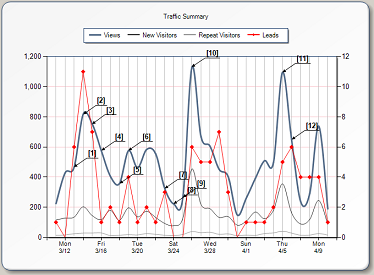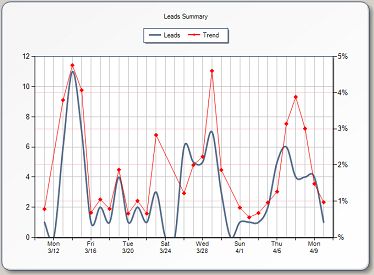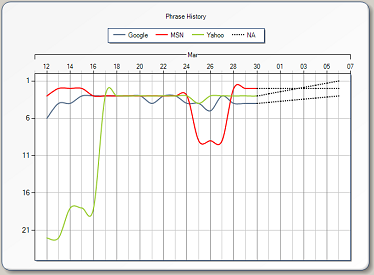I have been talking to a lot of b2b marketing people lately about their Internet marketing programs. One of the first questions I ask is "What are the most important statistics you track for your website?" The answers are sometimes surprising. About 40% of the time I hear "we don't really get any stats, we just know that sometimes people look at the website and call us." Another 40% of the time I hear "we get lots of statistics from [blank], but we really don't focus on a couple of them, we look at a lot of things" where [blank] is WebTrends, Google Analytics, Web Side Story, or another very detailed website analysis package.
Only about 20% of the time do I hear the right answer, which is "we track a few key statistics on a regular basis which are..." Why is this the right answer? Because focus is so important with business metrics - you can get lost in a sea of numbers very easily, and even convince yourself that things are going well when clearly they are not. Here is a list of the most important website statistics you should track so you can be like those 20% who know what they are doing.
I will also show you the charts that we use at HubSpot to evaluate these statistics over time. These charts, by the way, are automatically tracked and produced for any website using our Internet marketing software.
1) Visitors (new and repeat). This is the number of people who have come to your website for the first time or who are coming back for a second time. This is important, because this is the size of the pool of people from which you are trying to get leads. The bigger the number of visitors, the more potential for you to get leads.
This graph shows New Visitors, Repeat Visitors and Leads
2) Leads. This is the number of people who self-select on your website and do something to give you their contact information. It could be signing up for a demonstration, requesting a whitepaper, or viewing a video, but there must be a form where they give you at least their email address and sometimes more information as well. This number is critical since your website leads are where your sales come from.
3) Conversion Rate. This is the percentage of your total website visitors who become a lead. So, if you had 200 visitors to your website today, and you generated 3 leads, that would be a 1.5% conversion rate. Most people will tell you that a 1-2% conversion rate is the average for a b2b website. The conversion rate is important because it is telling you how efficient your website is at turning visitors into leads. Remember, you can double your company's number of leads by either doubling your website traffic or doubling your conversion rate. If you want tips on how to raise your conversion rate to get more leads, check out this article on Increasing your Website Conversion Rate.
This graph shows Leads and Conversion Rate
4) Website Grade. The free tool at www.websitegrader.com gives you an excellent overview of the marketing effectiveness of your website, including things like your Google PageRank, number of inbound links and other key statistics. What is nice about the Website Grade is that it summarizes this all into one number from 1 to 100. You should know what your website grade is and track it over time to make sure you improve (or if you already get a good score, to make sure you don't slip).
5) Keyword Search Rank. For most business websites, the most efficient traffic and leads will come from organic search. This is the traffic that comes from people searching on Google, MSN and Yahoo and other engines and finding your website in the results. This traffic is not completely "free", since you need to work on your website to really maximize it, but it is usually much more cost effective than other sources. You need to know how you rank in the search engines for at least a few key terms related to your business, and you also want to know how that rank is changing over time - are you moving up or down - since that will determine the future success of your website visitors and leads.
This graph shows historical Keyword Search Rank for a search term
BONUS: 6) Close Rate. I almost didn't put this here since very few businesses measure their close rate effectively and it is also something that for most b2b websites takes place offline (on the phone or in person), so it isn’t technically even a website metric, but it is so important I still have to list it. The close rate is the percentage of leads that close into customers in a specified time period. This is important to know because once you have your conversion rate and your close rate, you can actually put a value on your website traffic. For instance, let’s say each new customer you add is worth $5000 to your business in profits over the lifetime of the customer. If your close rate is 10%, then each lead is worth $500 to your company ($5000 x 10%). If your website conversion rate is 1%, then you also know that each visitor to your website is now worth $5. Knowing this, you can start marketing programs that drive traffic to your site for any cost up to $5 per visitor, so it is a useful number. Just be sure to check the traffic quality to verify that the new traffic has a similar conversion rate and close rate to the rates you used for this calculation, otherwise you will not be making money.
Summary / Next Steps: I am sure you can use a combination of your web analysis software and Excel to get charts that look like the ones I have shown here. If you liked this article, and would be interested in getting these statistics in charts like these which are produced automatically for your website in real time, check out HubSpot Internet marketing software. Didn’t like the article? Do you have other website metrics you prefer? Leave a comment and let me know what they are and why you like them better.
Web Analytics




![How Many Visitors Should Your Website Get? [Data from 400+ Web Traffic Analysts]](https://53.fs1.hubspotusercontent-na1.net/hubfs/53/how-much-traffic-does-website-get.png)



![What Is the Average Time Spent On a Website? [+ How to Improve It]](https://53.fs1.hubspotusercontent-na1.net/hubfs/53/GettyImages-1356122303%20copy.jpg)

![6 Steps to Reduce Your Bounce Rate [+ Platform-Specific Tips]](https://53.fs1.hubspotusercontent-na1.net/hubfs/53/decrease-bounce-rate.jpg)
